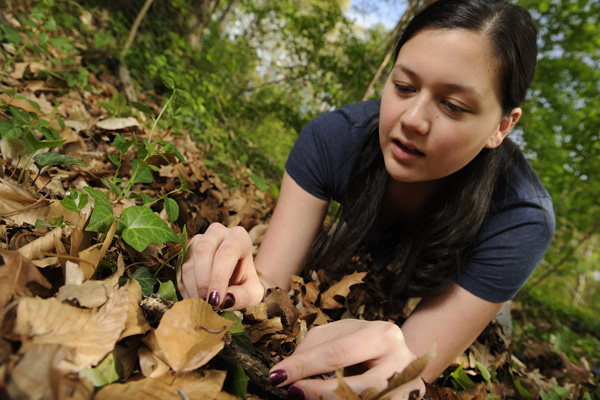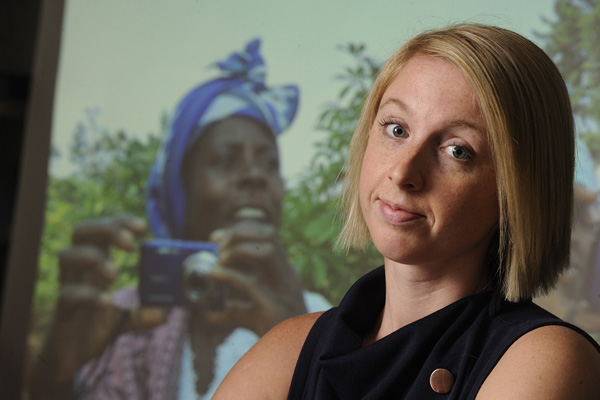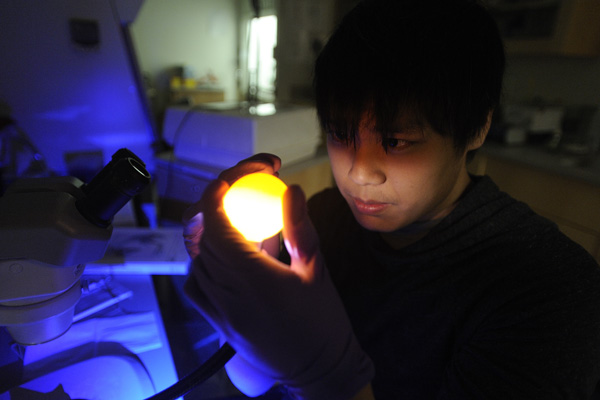April 23, 2012
Digging into research
PURA grants in hand, 46 JHU undergrads explore new territory

Decaying leaves are fertile ground for junior Natalie Bray’s exploration of how levels of carbon dioxide affect the palatability of insects’ food sources. Her PURA project, her adviser says, represents a hot new topic in soil ecology. Photo: Will Kirk/Homewoodphoto.jhu.edu
Natalie Bray spent part of last summer poking around in woods just south of Annapolis. On one excursion, the Johns Hopkins junior came across a red and black North American millipede (Narceus americanus), a “monster” some five inches long with row upon row of tiny red legs.
She couldn’t wait to grab it.
“I really like collecting,” says Bray, who is majoring in Earth and planetary sciences. “I’m not squeamish. I’ve always liked bugs. I guess some folks think I’m strange like that.”
Bray needed the crawly critter for her Provost’s Undergraduate Research Award project. The Los Angeles native wanted to study the impact of increased levels of atmospheric carbon dioxide on leaf litter palatability and chemistry.
Leaf chemistry, Bray says, is sensitive business. Soak up too much CO2, and the leaves could become an unappetizing snack for animals like millipedes, pill bugs and earthworms that eat dead and decaying plant matter. Or, even if the invertebrates do chow down, the altered chemistry of the leaves they’re ingesting could alter the composition of their droppings that enrich the soil.
“The complex carbons in the leaves decompose much more slowly without earthworms and arthropods, such as millipedes,” Bray says. “By eating and digesting the leaves, they transform these compounds into simpler carbon and nitrogen forms. This process makes the soil rich enough for trees and plants to grow.”
Since 1993, the PURAs have allowed students like Bray the opportunity to dig into important questions and explore ideas that could take them to a forest floor, a high-tech lab or across continents.
This year, grants of up to $2,500 funded 46 original research projects proposed and carried out during summer and fall 2011 by students in each of the university’s four schools with full-time undergraduates: the Krieger School of Arts and Sciences, the Whiting School of Engineering, the Peabody Conservatory and the School of Nursing.
Mentored by faculty from across the university, the students pursued a variety of research activities, such as looking at the impact of new media in the Arab world, engineering brain tumor cells with built-in oxygen sensors, undertaking a constitutional and political examination of the same-sex marriage debate, optimizing mucus-penetrating nanoparticles for the delivery of lung-cancer drugs and investigating the life and times of a little-known restaurateur and opera theater impresario in 19th-century New York. (See facing page for a complete list of projects.)
Through donations from the Hodson Trust, the Provost’s Undergraduate Research Awards program has supported 855 student endeavors over the past 19 years. In total, the Hodson Trust has contributed more than $3.5 million in both operating and endowment support to the PURA program.
Scott Zeger, vice provost for research at Johns Hopkins, says that the awards are an important part of the university’s mission and its commitment to research opportunities for undergraduates.
In a recent internal study, roughly one-third of Johns Hopkins juniors and seniors in the schools of Arts and Sciences and Engineering said that they were doing research or independent study in the current academic year through such programs as PURA, Woodrow Wilson fellowships or other. Roughly 13 percent of freshmen and sophomores in the Homewood schools said that they are participating in research or independent study. While precise numbers are not available, an estimated 40 percent of Johns Hopkins undergraduates will participate in some level of independent study or sponsored research before they graduate, according to statistics from the Provost’s Office.
Zeger says that through research, students learn key skills such as how to frame a question, gather evidence, interpret findings, form a conclusion and practice self-criticism. He says it also allows them to grow as individuals.
“These experiences are also about personal discovery,” he says. “The students come to understand their strengths and weaknesses, and abilities they didn’t think they had. Perhaps the way they thought about their problem wasn’t accurate and they had to adjust their thinking. This all leads them to a heightened sense of intellectual maturity and a newfound sense of confidence.”
On Tuesday, May 1, Lloyd Minor, provost and senior vice president for academic affairs, will host the annual PURA ceremony to honor the achievements of the program’s student researchers. The program will be held in the Glass Pavilion at Homewood. The entire Johns Hopkins community is invited to the event, which begins at 3 p.m. with an informal poster session allowing students to display and talk about their projects. A recognition ceremony hosted by Provost Minor will begin at 4:30 p.m. and will include student performances.
“I think it’s brilliant, the best day of the year,” Zeger says. “I’m always impressed and gratified by the quality of the work. And it’s fun to watch the faculty hovering around, beaming with their own sense of pride.”
The posters and presentations themselves tell a story of the discovery process, which sometimes brings more questions than answers.
For Bray’s project, the arthropods she collected ate the leaves, even some sweetgum from Oak Ridge, Tenn., that had been exposed to 12 years of elevated CO2 levels and had turned a dark brown color, as compared to the normal orange brown of that particular leaf.
“They didn’t seem to hate it like I thought they might,” she says.
The next step, then, was to determine if the insects’ droppings were chemically similar in terms of carbon and nitrogen to the “normal” droppings. Specifically, she was interested in the carbon and nitrogen content, and the carbon isotope ratio, in the leaves, the animal tissue and the droppings. She is currently awaiting final data from a stable isotope facility where all her samples are being analyzed.
Bray’s faculty adviser, Katalin Szlavecz, says that the impact of elevated C02 levels on the productivity of ecosystems deserves very close examination, as it has ramifications for every living thing, from the tiniest insect that eats the leaves to humans who eat the fruit off trees.
“Natalie’s project represents a hot new topic in soil ecology. Understanding the soil food web is extremely challenging, and stable isotopes are a promising tool toward this goal,” says Szlavecz, an associate research professor in the Morton K. Blaustein Department of Earth and Planetary Sciences. “If successful, this method allows us to follow carbon from leaves through the soil food chain.”
For her project, Bray traveled to the Smithsonian Environmental Research Center in Edgewater, Md., and to Hawk Mountain, Pa., to collect millipedes and isopods. Some students go much farther afield to conduct their research, like School of Nursing student Sarah Bristol.
Bristol flew to the Democratic Republic of Congo last summer to conduct a “Photovoice” project to document the persistent impact of war and violence on the country’s women and children, and to better understand the role of solidarity groups in the health and well-being of these people.
The Congo has experienced armed conflict since the 1990s, and sexual violence has been a common weapon used against women, men and children to destabilize families and communities.
Bristol spent six weeks in the Congo and conducted her study in the Murhali Village in the nation’s Walungu Territory—a far cry from her small hometown of White Lake, Wis.
The study’s 14 participants were members of a solidarity group sponsored by a local nongovernmental organization, Foundation RamaLevina, or FORAL. The group originally formed from a small band of women who gathered outside a local clinic. The individuals had already been seen and treated at the clinic but kept returning because they had mental wounds left to heal and wanted someone to listen.
Bristol gave these women digital cameras, taught them how to use them and asked them to document their lives prior to, during and after the armed conflict. She says that the photos exceeded her expectations.
“Their ideas were so clever and powerful,” she says.

Nursing student Sarah Bristol traveled to the Congo for her ‘Photovoice’ project. Photo: Will Kirk/Homewoodphoto.jhu.edu
The women would, for example, take pictures of other people’s animals to illustrate their lives as farmers prior to the conflict. Some took pictures of small children perched high on tree branches to depict how they would hide their own children when armed rebels came to town. To illustrate their current conditions, some photographed food to show how important nutrition had become in their lives. They gave every picture a title and an explanation.
Bristol and other members of her research team later interviewed the women, through a translator, to review their photos and discuss the meaning assigned to them. Some common themes appeared, such as their happiness and strength before the war, the survival strategies used during the conflict, and life post-conflict, which included joining together and rebuilding lives.
The notes from the interviews were used for analysis by FORAL staff, and each participant then presented her photographs and told her stories to women in her own solidarity group.
Bristol says that her project has opened a new line of communication between FORAL and the women it serves.
“Photovoice methodology is being integrated into FORAL’s evaluation of program activities to provide ongoing opportunity for women and other participants to provide insight and suggestions into needed activities and resources,” she says. “The women also shared with me that they want people outside their community to see how hard they are working to improve their own lives and the lives of their families. They want other women to have this opportunity as well.”
Some PURA projects, like Simon Pan’s, are more traditionally lab-based and conducted right in Baltimore.

Junior Simon Pan studied the role of the Pax6 gene in optic vesicle formation. Photo: Will Kirk/Homewoodphoto.jhu.edu
Pan, a junior majoring in molecular and cell biology, used his PURA grant to study the role of the Pax6 gene in optic vesicle development; in particular, its role in promoting retinal cell survival at these early stages.
Pax6 functions as a master regulatory gene for eye development and is involved in regulating cell cycle events, proliferation and neuronal specification and differentiation.
Pan’s project follows up on previous findings from a Wilmer Eye Institute lab where he works. By “knocking down” Pax6 expression in cells of the developing retina in chicken embryos, Pan and the lab staff found that in addition to a small eye phenotype and a failure of the optic lens to develop, the loss of Pax6 function led to massive amounts of apoptosis, or programmed cell death.
In his study, Pan characterized the apoptotic pathway triggered by the loss of Pax6 that leads to retinal cell death. He concluded that Pax6 has a novel function in promoting retinal cell survival at these stages, and that loss of Pax6 triggers a cell-intrinsic death mechanism mediated by molecules known as caspases.
Pan, who is from Honolulu, says that retinal degeneration diseases are a direct result of retinal cells undergoing apoptosis when they shouldn’t be, and so, understanding the molecular mechanisms by which cells die is critical in developing pharmaceutical interventions to attempt to rescue these dying cells.
“The hope is that understanding Pax6’s role in cell survival will aid in understanding certain diseases of the eye, such as glaucoma, which involves the degeneration of retinal ganglion cells,” he says.
M. Valeria Canto-Soler, Pan’s adviser and an assistant professor of ophthalmology in the School of Medicine, says that Pan’s natural curiosity and propensity to scientific thinking led him to review the literature related to the topic he was already working on in her lab, elaborate his own hypotheses and design the experiments to test them.
“With his work, Simon has contributed to our understanding of the molecular mechanisms controlling the survival of the cells that give rise to the retina during embryonic development,” Canto-Soler says. “Also, importantly, he has established several new experimental tools that will be very useful for many of the projects in our lab.”
Pan says that his PURA experience has only solidified his love of research.
“There can be such a sense of joy and a feeling of discovery when your work has created new knowledge, something that nobody else knew,” he says. “It really is an incredible feeling, and worth all the time you put into doing the work.”
Applications are now being accepted for the 2012 Provost’s Undergraduate Research Awards, which provide up to $2,500 or academic credit to students to work on original research projects with Johns Hopkins faculty. For more information, go to jhu.edu/provost.

